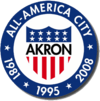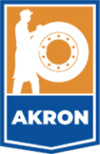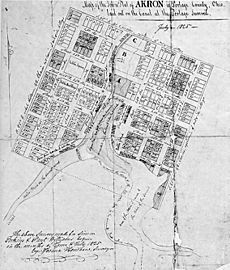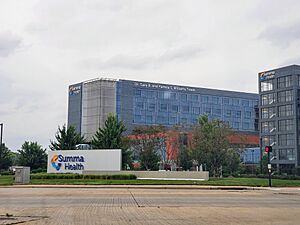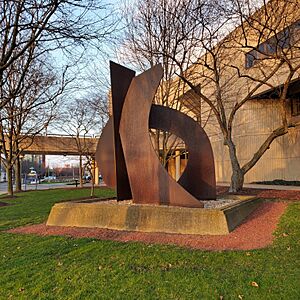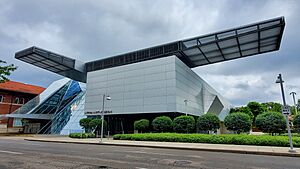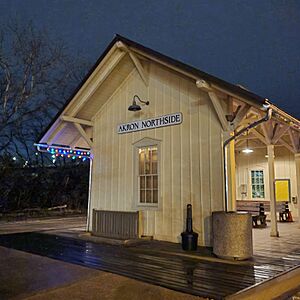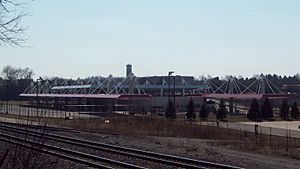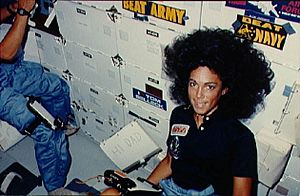Akron, Ohio facts for kids
Quick facts for kids
Akron
|
|||||
|---|---|---|---|---|---|
|
|
|||||
|
|||||
| Etymology: from Ancient Greek [ἄκρον (ákron)] Error: {{Lang}}: text has italic markup (help), meaning 'summit, high point' | |||||
| Nicknames:
Rubber City, City of Invention, Rubber Capital of the World (historical)
|
|||||
| Country | United States | ||||
| State | Ohio | ||||
| County | Summit | ||||
| Founded | 1825 | ||||
| Incorporated | 1836 (village) | ||||
| Incorporated | 1865 (city) | ||||
| Founded by |
|
||||
| Government | |||||
| • Type | Mayor–council | ||||
| Area | |||||
| • City | 62.27 sq mi (161.29 km2) | ||||
| • Land | 61.93 sq mi (160.41 km2) | ||||
| • Water | 0.34 sq mi (0.88 km2) 0.55% | ||||
| Elevation | 945 ft (288 m) | ||||
| Population
(2020)
|
|||||
| • City | 190,469 | ||||
| • Estimate
(2023)
|
188,701 | ||||
| • Rank | US: 136th | ||||
| • Density | 3,075.40/sq mi (1,187.42/km2) | ||||
| • Urban | 541,879 (US: 79th) | ||||
| • Urban density | 1,802.4/sq mi (695.9/km2) | ||||
| • Metro | 702,219 (US: 83rd) | ||||
| Demonym(s) | Akronite | ||||
| Time zone | UTC−5 (Eastern (EST)) | ||||
| • Summer (DST) | UTC−4 (EDT) | ||||
| ZIP Code |
44301-44321, 44325-44326, 44328, 44333-44334, 44372, 44396, 44398
|
||||
| Area codes | 234, 330 | ||||
| FIPS code | 39-01000 | ||||
| GNIS feature ID | 1086993 | ||||
Akron is a city in Ohio, United States. It's the main city of Summit County. In 2020, about 190,469 people lived here, making it the fifth-largest city in Ohio. Akron is located in Northeast Ohio, about 40 miles (64 km) south of Cleveland.
The city was started in 1825 by Simon Perkins and Paul Williams. Its name comes from the Greek word ákron, which means "summit" or "high point." This is because it was built on a high spot along the Ohio and Erie Canal. For a short time, it was called South Akron, but it merged with North Akron in 1836 to become one village. In the 1910s, Akron grew very fast, becoming one of the quickest-growing cities in the U.S.
Akron is famous for making rubber and tires, especially because of the Goodyear Tire and Rubber Company. This is why it's known as the "Rubber Capital of the World." It was also a big center for building airships. Today, Akron's economy includes making things, education, healthcare, and medical research. Some of its biggest employers are Akron Children's Hospital and FirstEnergy. Important places to visit include the Akron Art Museum, Akron Civic Theatre, Stan Hywet Hall and Gardens, and the University of Akron.
Akron has been part of many important historical moments. For example, the Akron School Law of 1847 created the K–12 school system we use today. Alcoholics Anonymous was also founded here. The city has seen important speeches about fairness and equality by famous people like Sojourner Truth in 1851 and President Bill Clinton in 1997.
Contents
History of Akron
The first person to settle in the Akron area was Major Miner Spicer in 1810. He built a log cabin and later brought his family. In 1811, Paul Williams suggested to General Simon Perkins that they start a town where the Ohio and Erie Canal would be built. They chose the name Akron, meaning "high point" in Greek, because of its location. The town was planned in December 1825. Many Irish workers building the Ohio Canal also built cabins nearby.
In 1833, Eliakim Crosby started "North Akron." About three years later, North Akron and the original Akron joined together to become one village in 1836. In 1840, Summit County was formed, and Akron became its main city a year later. A new canal connecting to Beaver, Pennsylvania, helped new industries like pottery and farming tools grow. In 1844, John Brown, a famous abolitionist (someone who wanted to end slavery), lived in Akron.
The Akron School Law of 1847 created the city's public schools and the K–12 grade system, which is now used across the U.S. The city's first school is now a museum.
Akron in the Late 1800s
In 1851, Sojourner Truth gave her famous "Ain't I A Woman?" speech at a women's rights meeting in Akron. In 1870, a local businessman named John R. Buchtel started Buchtel College, which later became the University of Akron in 1913.
Ferdinand Schumacher started a mill in 1856 and made oat bars for soldiers during the American Civil War. These became very popular. Akron officially became a city in 1865. In 1872, the "Akron Plan" for church buildings was created in Akron and became very popular across the country.
In 1883, a local journalist started the modern toy industry by founding the Akron Toy Company. The next year, the first mass-produced clay marbles were made here. Other toys invented in Akron include rubber balloons, ducks, and balls. In 1895, the first long-distance electric railway started service in Akron. In 1889, Akron was nicknamed "Summit City." The city also used the first electric police car in the U.S.
Akron: The Rubber Capital of the World (1900s–1990s)
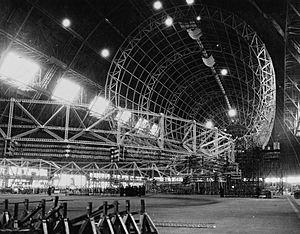
Akron became known as the "Rubber Capital of the World" because four major tire companies were based here: B.F. Goodrich, Goodyear Tire and Rubber Company, Firestone Tire and Rubber Company, and General Tire. These factories created many jobs, including for deaf people, which led to Akron being called the "Crossroads of the Deaf."
From 1916 to 1920, a special project called the "Akron Experiment" successfully used iodized salt to prevent a health problem called goiters. Rubber companies built affordable homes for their workers, like the Goodyear Heights and Firestone Park neighborhoods. Between 1910 and 1920, Akron's population grew by over 200%, making it America's fastest-growing city. Many new residents were immigrants from Europe and other parts of the U.S.
Goodyear also built large airships for the U.S. Navy, like the USS Akron and USS Macon, in the 1920s and 1930s. They also made blimps for advertising. In 1936, workers at rubber factories went on strike, using a "sit-down" tactic to win better rights.
Like many other industrial cities, Akron's tire and rubber industries faced challenges. By the early 1990s, Goodyear was the last major tire maker still based in Akron.
Akron: City of Invention (2000s)
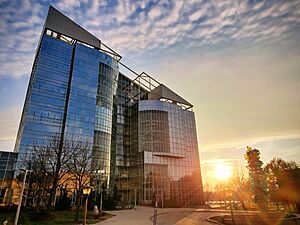
Even though fewer people worked in rubber factories, Akron became known for its research in polymers (materials like plastics and rubber). This research is centered at the University of Akron, which has the Goodyear Polymer Center and the National Polymer Innovation Center. Because of its contributions to new technologies, Newsweek magazine called Akron one of the top high-tech places in 2001. In 2008, Akron received the "All-America City Award" for the third time, and "City of Invention" was added to its seal.
Goodyear opened its new main office in Akron in 2013, showing its strong connection to the city. Another tire company, Bridgestone, also built a new research center here.
Akron's History of Fairness and Equality
Akron has a history of working towards fairness and equality. In 1807, city founder Simon Perkins helped create a mail route by making a treaty with Native Americans. John Brown, a famous person who fought against slavery, lived in Akron, and there are landmarks dedicated to him.
In 1851, Sojourner Truth gave her powerful "Ain't I A Woman?" speech in Akron. In 1905, a statue of an Indian named Unk was put up on Portage Path, which was once a boundary between lands. Important speeches about race were also given in Akron by W. E. B. Du Bois in 1920 and President Bill Clinton in 1997.
Geography of Akron
Akron is located in the Great Lakes region, about 39 miles (63 km) south of Lake Erie. It sits on the western edge of the Glaciated Allegheny Plateau, which means it has rolling hills. The Ohio and Erie Canal runs through the city, dividing it into east and west parts. Akron also has a special facility that turns waste into clean energy.
The city covers about 62.37 square miles (161.54 km2), with most of it being land.
Akron's Climate
Akron has four distinct seasons. Winters are cold with a mix of rain, sleet, and snow. Summers are usually warm and humid. Spring and autumn are generally pleasant. The highest temperature ever recorded in Akron was 104°F (40°C) in August 1918, and the lowest was -25°F (-32°C) in January 1994.
Akron's Neighborhoods
Akron has 21 official neighborhoods, plus three more that are recognized. These areas look different because the city grew by joining towns and building new homes over time.
- Maple Valley is on the west side of Copley Road and has many businesses.
- Spicertown is part of University Park, known for shops and homes around the University of Akron.
- West Hill has many old, grand homes, especially in the Oakdale Historic District.
Akron's Nearby Towns
Akron's suburbs include Barberton, Cuyahoga Falls, Fairlawn, Green, Hudson, Mogadore, Munroe Falls, Norton, Silver Lake, Stow, and Tallmadge.
People of Akron
| Historical population | |||
|---|---|---|---|
| Census | Pop. | %± | |
| 1840 | 1,664 | — | |
| 1850 | 3,266 | 96.3% | |
| 1860 | 3,477 | 6.5% | |
| 1870 | 10,006 | 187.8% | |
| 1880 | 16,512 | 65.0% | |
| 1890 | 27,601 | 67.2% | |
| 1900 | 42,728 | 54.8% | |
| 1910 | 69,067 | 61.6% | |
| 1920 | 208,435 | 201.8% | |
| 1930 | 255,040 | 22.4% | |
| 1940 | 244,791 | −4.0% | |
| 1950 | 274,605 | 12.2% | |
| 1960 | 290,351 | 5.7% | |
| 1970 | 275,425 | −5.1% | |
| 1980 | 237,177 | −13.9% | |
| 1990 | 223,019 | −6.0% | |
| 2000 | 217,074 | −2.7% | |
| 2010 | 199,110 | −8.3% | |
| 2020 | 190,469 | −4.3% | |
| 2023 (est.) | 188,701 | −5.2% | |
| U.S. Decennial Census 2020 census | |||
In 2020, Akron had 190,469 people. The city's population has changed over time, with a decrease between 1960 and 2020.
Akron is part of the larger Cleveland–Akron–Canton Combined Statistical Area, which has over 3.5 million residents.
Akron's Economy
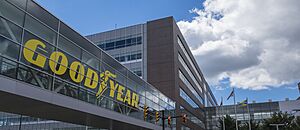
Akron has played a big role in many industries in the United States. It became the "Rubber Capital of the World" after companies like BFGoodrich, Firestone, General Tire, and Goodyear started here.
Akron has won awards for its economy and livability. It's known as a "high-tech haven" for its contributions to the Information Age. Today, major companies like Goodyear and FirstEnergy have their main offices in Akron. Other important companies include GOJO and Sterling Jewelers. Goodyear recently built a new world headquarters in the city. Bridgestone also built a new research and development center here.
Polymer Valley
Akron is at the center of Northeast Ohio's "Polymer Valley." This area has many companies that work with polymers, which are materials like plastics and rubber. The University of Akron is a leader in polymer research, with its Goodyear Polymer Center and the National Polymer Innovation Center.
Hospitals in Akron
Akron has a special area called the Biomedical Corridor, which aims to attract health-related businesses. This area includes major hospitals like Summa Akron City Hospital, Akron Children's Hospital, and Akron General Medical Center.
Akron Children's Hospital is famous for its care for kids and burn victims. In 1974, doctors at Akron Children's were the first in the world to successfully grow human skin in a lab to treat burn patients. Both Akron City and Akron General hospitals are top-level trauma centers, meaning they can handle very serious injuries.
Top Employers in Akron
Here are some of the biggest employers in Akron:
| # | Employer | Employees |
|---|---|---|
| 1 | Summa Health System | 8,609 |
| 2 | University of Akron | 5,933 |
| 3 | Akron Children's Hospital | 5,773 |
| 4 | FirstEnergy | 5,538 |
| 5 | Cleveland Clinic- Akron General | 4,779 |
| 6 | Akron Public Schools | 4,544 |
| 7 | Summit County | 3,323 |
| 8 | Goodyear Tire & Rubber Company | 2,954 |
| 9 | City of Akron | 2,406 |
| 10 | Signet Jewelers | 2,094 |
Arts and Culture in Akron
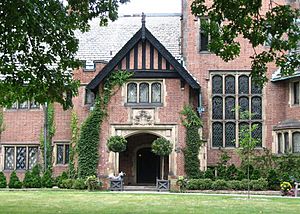
Akron has many places for arts and culture. E. J. Thomas Hall hosts performances by the Akron Symphony Orchestra, Broadway shows, ballets, and more. The Akron Civic Theatre, which opened in 1929, is a beautiful old movie palace with a starry sky ceiling.
Lock 3 Park downtown is an outdoor amphitheater that hosts concerts and festivals, including the annual First Night Akron celebration on New Year's Eve. The Akron Art Museum shows art from 1850 to today and has special exhibits. It moved into a renovated post office building in 1981 and greatly expanded in 2007.
Stan Hywet Hall and Gardens is a large historic house built between 1912 and 1915 for Frank Seiberling, the founder of Goodyear. It's one of the biggest historic homes in the U.S. and hosts many public events. The F.A. Seiberling Nature Realm, located in Sand Run Metro Park, has hiking trails, ponds, and gardens. Akron also has the American Marble and Toy Museum.
Akron's Architecture
Akron's buildings show its varied history, from its canal town beginnings to its industrial boom. The city is divided by the Ohio and Erie Canal, and there's a path along the canal paved with rubber.
Akron won the "City Livability Award" in 2008 for turning new school buildings into community learning centers. The National Arbor Day Foundation has also recognized Akron as a "Tree City USA" many times.
Many government buildings in Akron are from before World War II, but the Akron-Summit County Public Library and John S. Knight Center are newer. The library was greatly expanded in 2004.
The Akron Civic Theatre is a historic movie palace from the 1920s, known for its unique design that makes you feel like you're under a starry sky.
Akron's tallest building, the Huntington Tower, was finished in 1931 and has an art deco style. The Goodyear Polymer Center on the University of Akron campus has twin glass towers connected by walkways. The old Quaker Oats factory, once a shopping center called Quaker Square, was used as a dormitory by the university.
Tourism in Akron
Akron has many fun places to visit.
- The Akron Art Museum has a large collection of art from 1850 onwards.
- Stan Hywet Hall and Gardens is a beautiful estate that hosts events all year.
- The Akron Civic Theatre offers live shows and entertainment.
- Lock 3 Park is an outdoor amphitheater that hosts festivals and concerts.
- The Akron Zoo is a great place to see animals.
- Art in the Square is an annual festival in Highland Square that celebrates local artists and musicians.
Akron also hosts national events:
- The Bridgestone Invitational golf tournament used to be held at Firestone Country Club.
- The All-American Soap Box Derby World Championship finals take place at Derby Downs.
- The National Hamburger Festival is held in July.
- First Night Akron is a New Year's Eve celebration at Lock 3 Park.
- Founders Day is celebrated annually because the organization started in Akron.
Akron's Food History
Akron has contributed to American food. Ferdinand Schumacher created the first American oatmeal and helped start the Quaker Oats Company. The Menches Brothers, who lived in Akron, are believed to have invented the waffle ice cream cone, caramel corn, and the hamburger. Strickland's Frozen Custard is also a local favorite.
Sports in Akron
Professional Sports Teams
| Team | Sport | League | Venue (capacity) | Attendance |
|---|---|---|---|---|
| Akron RubberDucks | Baseball | Eastern League (AA) | Canal Park (7,630) | 5,074 |
| Akron Aviators | Basketball | American Basketball Association | Innes Community Learning Center | |
| Akron City FC | Soccer | National Premier Soccer League (Rust Belt Conference) | Green Street Stadium (3,000) | 625 |
College Sports Teams
| Team | Sport | League | Venue (capacity) | Attendance |
|---|---|---|---|---|
| Akron Zips football | American football | Mid-American Conference (NCAA) | InfoCision Stadium (30,000) | 18,098 |
| Akron Zips men's basketball | Basketball | Mid-American Conference (NCAA) | James A. Rhodes Arena (5,500) | 3,351 |
| Akron Zips men's soccer | Soccer | Big East
(NCAA) |
FirstEnergy Stadium (4,000) | 2,186 |
Sports Overview

The Akron RubberDucks baseball team moved to Akron in 1997 and have won the Eastern League Championship many times.
The Akron Marathon is an annual running event with different races. The All-American Soap Box Derby has been held at Derby Downs since 1936. LeBron James hosts a "King for Kids bike-a-thon" in June.

The University of Akron's sports teams, called the Akron Zips, compete in the NCAA Division I. Their men's soccer team won the national championship in 2010. Zippy, the University of Akron's mascot, won the National Mascot of the Year contest in 2007.
Akron has also been home to many past sports teams, including football, basketball, and hockey teams. The city also hosted some events for the 2014 Gay Games, including the marathon and golf tournaments. The Firestone Country Club has hosted major golf tournaments like the PGA Championship.
Parks and Recreation in Akron
Summit Metro Parks manages the park system in Akron. Key parks include Lock 3, Firestone, Goodyear Heights, and parts of Cuyahoga Valley National Park.
Many parks are located along the Ohio and Erie Canal. Lock 3 Park in downtown Akron has an outdoor amphitheater for music and events. In winter, it becomes an ice-skating rink. Near Derby Downs, there's a large outdoor skatepark and a BMX racing course. You can also go ice skating year-round at the historic Akron Ice House.
The Ohio and Erie Canal Towpath Trail is a popular path for biking and hiking that follows the canal. It even has a floating observation deck over Summit Lake.
Education in Akron
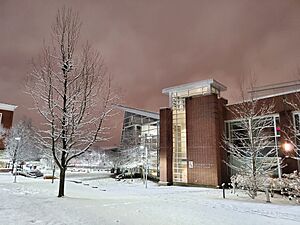
Most schools in Akron are part of the Akron City School District. The idea for free public schools in Akron started in 1840 and was approved in 1847. This led to the creation of the K–12 grade school system that is now used across the U.S.
In the 1920s, Akron schools had programs to help new immigrant students learn English and adapt to American life.
As part of his charity work, NBA player LeBron James founded the I Promise School in Akron, which helps children who need extra support.
The city is home to the University of Akron. This university is known for its Goodyear Polymer Center and the National Polymer Innovation Center, focusing on the science of materials like plastics and rubber.
All Akron Public Schools are being rebuilt as part of a large project. The school district has been recognized by the Ohio Department of Education for its improvements. Akron also has many private and charter schools.
Media in Akron
Print Media
Akron has a daily newspaper called the Akron Beacon Journal. There are also weekly newspapers like "The Akron Reporter" and West Side Leader, and a monthly magazine called Akron Life. The University of Akron publishes its own newspaper, The Buchtelite.
TV in Akron
Akron is part of the larger Cleveland-Akron-Canton TV market. While there are TV stations licensed to Akron, they serve the whole area and Akron doesn't have its own local news broadcast.
Radio in Akron
Akron has its own radio market with several stations. These include music stations like WQMX 94.9 (Country), WONE 97.5 (Classic rock), and WKDD 98.1 (Contemporary Hits). There are also news/talk stations like WHLO 640 and WNIR-FM 100.1, and religious programming on WCUE 1150 and WKJA 91.9.
WKSU 89.7 is the regional NPR station that serves all of Northeast Ohio. The University of Akron has its own student-run station, WZIP 88.1.
Akron in Movies and TV
Akron has been the setting for several movies and TV shows.
- Dance, Girl, Dance (1940) is about two dancers from Akron who go to New York City.
- My Name is Bill W. (1989) tells the true story of Bill Wilson, who co-founded Alcoholics Anonymous in Akron.
- The movie More than a Game (2009) follows NBA star LeBron James and his high school basketball team from Akron.
- The city has been shown in TV shows like Seinfeld and Criminal Minds.
- The 2015 film Room is set in Akron.
Transportation in Akron
Airports
The main airport for travelers in Akron is the Akron–Canton Airport, located about 10 miles (16 km) southeast of the city. It serves nearly 2 million passengers a year. Akron Executive Airport is for private planes and cargo.
The Lockheed Martin Airdock in Akron was where Goodyear's airships and blimps were originally kept. Now, the Goodyear blimps are housed outside Akron at Wingfoot Lake.
Railroads
Akron Northside Station is a train station used by the Cuyahoga Valley Scenic Railroad.
In the past, many railroads served Akron because of its large rubber industry. Today, the city is served by freight railroads like CSX Corporation. Passenger train service to Akron ended in 2005. The closest Amtrak stations are in Alliance, Ohio or Cleveland.
Buses and Public Transit
Public transportation in Akron is provided by the METRO Regional Transit Authority, which operates buses and trolleys. They also have commuter buses to downtown Cleveland. The Stark Area Regional Transit Authority (SARTA) runs a bus line between Canton and Akron, and the Portage Area Regional Transportation Authority (PARTA) connects the University of Akron with Kent State University.
METRO RTA operates from the Robert K. Pfaff Transit Center, which also serves Greyhound Lines for longer bus trips.
Highways in Akron
Akron is served by two main interstate highways:
- Interstate 77 connects Akron to Marietta and Cleveland.
- Interstate 76 connects Akron to Youngstown, Ohio.
- Interstate 277 is a shorter highway that connects to I-76.
- The Akron Innerbelt is a highway that serves downtown Akron.
- Ohio State Route 8 connects Akron's northern suburbs to the interstates.
Notable People from Akron
Many famous people, called "Akronites," have come from Akron.
- General Simon Perkins, who helped found Akron.
- John Brown, a famous person who fought against slavery.
- Hugh Downs, a well-known broadcaster.
- Alan Freed, a pioneering rock 'n' roll DJ.
- John Dean, a figure from the Watergate era.
Famous athletes from Akron include:
- NBA champions LeBron James and Stephen Curry.
- Basketball Hall of Famers Gus "Honeycomb" Johnson and Nate Thurmond.
- Baseball player Thurman Munson.
- Boxer Gorilla Jones.
- NFL players Whitney Mercilus and James Harrison.
- Olympic medalist Clayton Murphy.
- Former NFL coach Mike Vrabel.
Performing artists from Akron include:
- Bands like Devo, The Black Keys, and The Cramps.
- Singers Chrissie Hynde (from The Pretenders), James Ingram, and Joseph Arthur.
- Actors like Melina Kanakaredes, Elizabeth Franz, and Ray Wise.
- Clark Gable and John Lithgow also lived in Akron.
Poet Rita Dove, who won a Pulitzer Prize for poetry, was born and grew up in Akron.
Inventors from Akron include:
- Stanford R. Ovshinsky, who invented the nickel-metal hydride battery.
- Richard Smalley, who won a Nobel Prize in Chemistry.
- Judith Resnik, the second U.S. female astronaut in space, who died in the 1986 Space Shuttle Challenger disaster. A moon crater is named after her.
- Harry Coulter Williams, who invented the "Silver Screen" for movies.
Carol Folt, the first woman to lead the the University of North Carolina at Chapel Hill, was born in Akron.
Sister Cities of Akron
Akron has two sister cities:
Images for kids
-
Cascade Plaza in downtown Akron
See Also
 In Spanish: Akron para niños
In Spanish: Akron para niños








